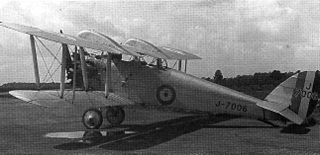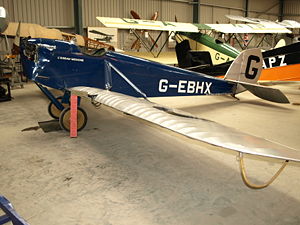
The de Havilland DH.89 Dragon Rapide is a 1930s short-haul biplane airliner developed and produced by British aircraft company de Havilland. Capable of accommodating 6–8 passengers, it proved an economical and durable craft, despite its relatively primitive plywood construction.

The de Havilland DH.87 Hornet Moth is a single-engined cabin biplane designed by the de Havilland Aircraft Company in 1934 as a potential replacement for its highly successful de Havilland Tiger Moth trainer. Although its side-by-side two-seat cabin made it closer in configuration to the modern aircraft that military trainee pilots would later fly, there was no interest from the RAF and the aircraft was put into production for private buyers.

The de Havilland DH.80A Puss Moth is a British three-seater high-wing monoplane aeroplane designed and built by the de Havilland Aircraft Company between 1929 and 1933. It flew at a speed approaching 124 mph (200 km/h), making it one of the highest-performance private aircraft of its era.

The Hawker Tomtit is a British training biplane from the late 1920s.

The de Havilland DH.91 Albatross was a four-engine British transport aircraft in the 1930s. A total of seven aircraft were built in 1938–39.

The de Havilland DH.84 Dragon is a successful small commercial aircraft that was designed and built by the de Havilland company.

The de Havilland DH.104 Dove is a British short-haul airliner developed and manufactured by de Havilland. The design, which was a monoplane successor to the pre-war Dragon Rapide biplane, came about from the Brabazon Committee report which, amongst other aircraft types, called for a British-designed short-haul feeder for airlines.

The de Havilland DH.60 Moth is a 1920s British two-seat touring and training aircraft that was developed into a series of aircraft by the de Havilland Aircraft Company.

The Avro Type 621 Tutor was a two-seat British radial-engined biplane from the interwar period. It was a simple but rugged basic trainer that was used by the Royal Air Force as well as many other air arms worldwide.

The DH.83 Fox Moth was a successful small biplane passenger aircraft from the 1930s powered by a single de Havilland Gipsy Major I inline inverted engine, manufactured by the de Havilland Aircraft Company.

The de Havilland DH.90 Dragonfly is a 1930s British twin-engined luxury touring biplane built by the de Havilland Aircraft Company at Hatfield Aerodrome.

The de Havilland DH.94 Moth Minor was a 1930s British two-seat tourer/trainer aircraft built by de Havilland at Hatfield Aerodrome, England, and by de Havilland Australia at Bankstown Aerodrome, Australia.

The de Havilland DH.93 Don was a 1930s British multi-role three-seat training aircraft built by de Havilland at Hatfield Aerodrome.

The de Havilland DH.50 was a 1920s British large single-engined biplane transport built by de Havilland at Stag Lane Aerodrome, Edgware, and licence-built in Australia, Belgium, and Czechoslovakia.

The Blackburn B-2 was a British biplane side-by-side trainer aircraft of the 1930s. Designed and built by Blackburn Aircraft, 42 were built.

The Supermarine Sparrow was a British two-seat light aircraft designed by R.J. Mitchell and built by Supermarine at Woolston.
The Gnosspelius Gull was a 1920s British experimental ultra-light monoplane designed by Major O.T. Gnosspelius and built by Short Brothers at Rochester for the 1923 Lympne light aircraft trials.

The de Havilland DH.42 Dormouse and its two variants the de Havilland Dingo I and II were two-seat single-engined biplanes designed for fighter-reconnaissance and army cooperation roles. They did not achieve production.

The Blackburne Tomtit was a 670 cc V-twin aero engine for light aircraft that was designed and produced by Burney and Blackburne Limited. Burney and Blackburne was based at Bookham, Surrey, England and was a former motorcycle manufacturer.
The Clarke Cheetah was a single-engined amateur built aircraft built in the UK using some parts from a de Havilland Humming Bird to produce a machine that could fly either as a biplane or as a parasol winged monoplane. The single example flew for five years before being converted again in 1936.


















